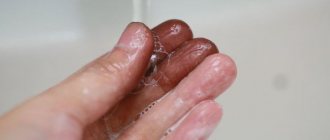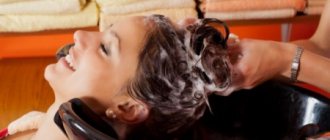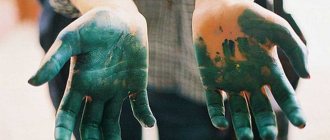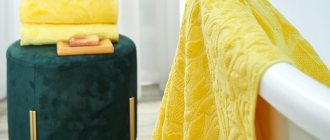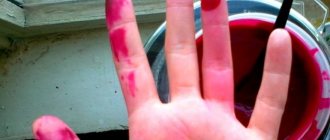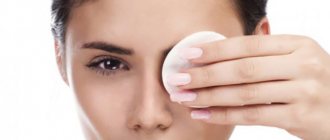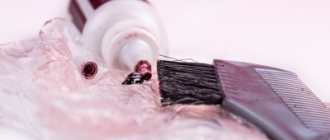During the hair coloring process, the dye gets onto the skin along the hairline, and may accidentally end up on the neck or cheek.
Even with very careful and diligent work, such situations cannot be avoided. How to remove hair dye from facial skin at home? You can remove paint from your face not only using professional products, but also by adopting simple home recipes.
Top 3 best washes
If you have a remover on hand, and in cases where home recipes do not help, you can use a professional product to remove traces of paint. The use of such drugs allows you to quickly and effectively cope with the problem.
Procedure for using removers:
- Using a cotton swab, apply the product undiluted to the stain.
- Rub.
- Remove any remaining remover with a napkin.
- Rinse with water.
As washes, it is best to use products from well-known manufacturers who guarantee the quality of their products.
Estel Skin Color Remover
Estel Skin Color Remover lotion has many advantages:
- does not contain ammonia;
- gives quick results;
- has simple application;
- does not dry out the skin;
- has a neutral pH level;
- It is inexpensive (about 300 rubles per package).
The packaging has a volume of 0.2 l. If used directly to remove occasional stains, it will last a long time.
London Stain Remover
The high popularity of the product from the famous company Londa is associated with a large number of advantages of the product:
- economical consumption;
- rapid achievement of effect;
- hypoallergenic composition.
The cost of a 0.15 liter package is about 500 rubles. Manufacturer – Germany. The remover can be used at home, and is also often used by professionals.
Schwarzkopf Professional Igora Color Remover
The remover from the German company Schwarzkopf has proven itself well in the market. Among its advantages are the following:
- safety of use;
- does not contain ammonia;
- contains castor oil;
- effective even on durable paint;
- ease of use;
- suitable for cleansing sensitive skin;
- Can be used to erase large stains.
The price of the product is about 600 rubles for a 0.25 liter bottle. Made in Germany.
Traditional methods
As a rule, professional hairdressers and stylists prefer to remove the product immediately during the coating process. If you don't miss the time, you can wipe off the composition with a cotton swab and warm water.
Otherwise, the stain may dry out, and its removal will take much longer and will require the use of special products or traditional recipes.
Soda
Baking soda is considered a simple, cheap and affordable remedy, which can always be found in the house. Therefore, even if coloring is done at home, the skin problem can be easily solved.
Mix two teaspoons of baking soda with warm water to form a thick paste and leave for 2 minutes. The composition is applied to contaminated areas of the face, gently massaging them. After a few minutes, the soda is washed off with warm running water.
In this way, you can also remove stains from the fingers and nails left from exposure to the dye. A heavily soiled nail can be rubbed with a mixture of baking soda and liquid dishwashing detergent.
Those with sensitive skin prone to allergic reactions are not recommended to use baking soda to get rid of paint stains, as it softens the epidermis and can cause irritation after the procedure.
Oil
The use of natural vegetable oil is considered a gentle and safe method. It has a softening effect, opens pores and removes stains.
Unrefined oil is thickly applied to a cotton swab and massaged into the contaminated area. Leave the product on the skin for an hour, then remove the residue with a soft cloth and wash off with warm water and soap. You can replace the oil with cold-pressed raw materials.
Ash
An ancient way to clean fabrics and hard surfaces from deep stains is to use ash or ash. They are able to remove and clean even the most difficult stains. For this purpose, you can use ash from cigarettes or burnt paper.
A cotton pad is moistened with water and sprinkled with ash. Apply it to dirty places and rub it. After a 3-minute exposure, rinse everything off with clean water. Wood ash is also suitable for such purposes.
Expert opinion
Catherine the Great
Dermatovenerologist, trichologist and cosmetologist
Experts do not recommend using coal ash, as it is a complex compound that easily eats into the epidermis.
Vinegar
Vinegar quickly removes color stains. For application to the skin, it is recommended to use malic or tartaric acid, as table vinegar can cause burns on the face or neck.
The substance is heated to a warm state in a water bath. Soak a cotton swab in it and apply lotions to the contaminated area for a couple of minutes. It is recommended to wash off the vinegar with warm water and detergent.
This method is well suited for effectively erasing dark spots near the hairline or from the scalp.
Kefir
Kefir is considered a safe ingredient in masks and homemade hair balms. It effectively removes color residue from the face, neck and hands.
Undiluted kefir is applied to the spots and the skin around them. Leave the dairy product on the epidermis for 15 minutes, then wash off with water.
Severe and deep stains are treated with a cotton swab soaked in it and wiped off after 30 minutes.
You can wash off the color from heavily soiled hands using baths. They are kept in the milk product for about a quarter of an hour, after which they are washed off with warm water.
Toothpaste
Dental and oral care products are not intended for use on the face or specific areas of the body. Use the paste to remove paint from acrylic bathtubs and sinks and whiten teeth. But in the absence of other means, it can also cleanse the skin of pigment residues.
Apply a thin layer of paste to the stain and leave until dry. Then rinse it thoroughly with water. Clean the area with moisturizer.
Expert opinion
Selyutina Marina Valerievna
MiracleMed Medical Center, 23 years of experience
For tanned and naturally dark skin, whitening pastes are not recommended.
Lemon
Lemon juice has excellent properties, so this citrus fruit is actively used to wash off hair dye residues.
Rub a slice of lemon onto the stain with light movements and leave for a few minutes. Then the acid is washed off with warm water and treated with a moisturizer.
You can also use a cotton swab dipped in fruit juice. Lemon for facial cleansing should only be used by those who do not have an allergic reaction to citrus fruits.
Features of washing off natural dyes
Natural dyes (basma and henna) are permanent. They are difficult to wash off not only from hair, but also from accidentally stained facial skin.
To remove natural dyes, the methods described above using:
- oils;
- hydrogen peroxide;
- soap;
- alcohol-containing lotion.
Since natural paints do not like high temperatures, before any of the procedures you can make preliminary applications with a heated towel.
It is also possible to use a slurry of lemon juice slaked with soda. It is carefully applied to the stains, lightly massaging, and after a minute, washed off with water.
Lemon juice and vinegar cannot be used in their pure form to remove natural dyes , since combining acid with paint will have the opposite effect - fixing the pigment on the skin.
What can you use to wipe your hands off?
More aggressive methods are suitable for hands:
Washing powder and soda:
- Bulk are mixed in a 1:1 ratio.
- Rub into dirt for a maximum of 1 minute.
- Wash thoroughly with warm water.
Washing powder + soda
Hydrogen peroxide is a well-known pigment bleaching agent:
- Cotton wool is soaked in liquid.
- Wipe your hands until completely clean.
Brush and soap. – Any clean toothbrush will do. The item is soaked in soap and water and the contaminated areas of the skin on the hands and under the nails are thoroughly scrubbed.
After the procedure with soap, it is not recommended to use a toothbrush for its intended purpose.
Hydrogen peroxide
Pigment from tint tonic: correcting the situation
Tinted balms and tonics are an option for temporary coloring of strands. These products are based on non-permanent dyes that are completely washed off from the hair within a few times.
It is much easier to wash off tint dye than permanent dye or henna . To remove stains, it may be enough to soap the stains several times with laundry soap, lightly rub and rinse with warm water.
If the coloring agent gets on your face, it must be washed off quickly with soapy water.
In addition to this method, you can use recipes with the following ingredients:
- alcohol-containing products;
- soda;
- shampoo;
- lemon juice.
How to remove hair dye from skin using specialized products
To remove hair dye from the skin, you can use special formulations designed specifically for cleansing facial skin.
- Makeup remover. Such solutions are ideal for removing coloring compounds, since tonics are developed specifically for quickly removing waterproof cosmetics. At the same time, makeup removers are as safe as possible for the skin itself; if you wipe off hair dye with them, no irritation will occur on the face. Good tonics do not cause harm even when used on the delicate skin of the eyelids, and even more so they can be used to wipe the forehead and temples without fear.
- Minor stains can be easily removed using ordinary wet wipes. In this way, you can remove hair dye from your hands or face immediately after dyeing, while it has not yet had time to be absorbed; if the dye has dried, then, most likely, you will have to use stronger products.
- Hair dyes that get on the skin are perfectly dissolved by Lokon, a chemical used for curling hair. But when using it, you need to understand that the composition of “Lokon” can cause irritation of the epidermis. In addition, the liquid has a strong unpleasant odor and can cause headaches.
We recommend reading: How to wash Fukortsin: from clothes, furniture, carpet
Advice! In cosmetic stores and shopping centers you can purchase specialized tonics and lotions, which are usually sold next to hair dye. Manufacturers take into account that when dyeing, the dye can end up not only on the hair, and they offer solutions to the problem in advance.
Recommendations from experts
When starting to remove paint from your face, it is advisable to follow these recommendations:
- Try to remove stains as soon as they appear.
- The face has sensitive skin that should not be subjected to excessive mechanical stress or contact with caustic chemicals.
- It is better to wipe off large stains with gloves so as not to stain your hands with paint.
- Professional products can cause an allergic reaction, so before the first use you should test the drug on the elbow.
- You should not, at your discretion, increase the exposure time of a remover or a homemade product, as this can lead to burns and inflammation.
- You can dye your hair only the next day after washing your hair. During this time, sebum is formed on the scalp, which serves as a natural protection. And prevents staining of the scalp.
- During the dyeing process, you should not mix natural (basma, henna) and chemical dyes.
Depending on whether permanent, unstable or natural paint was used, the approach to removing stains from the face, the intensity of exposure and the choice of recipes should be adjusted.
How to prevent stains after dyeing
Precautionary measures taken immediately before the coloring procedure will help protect the skin of the neck and face from unwanted stains.
Front zone protection
To prevent tinting of the line near the hair, when applying paint to them, it is recommended to follow the following rules:
- The coloring procedure should be carried out no earlier than 24 hours after the last hair wash. Natural sebum will serve as a repulsive factor for color penetration.
- Apply thick cream or Vaseline in a 1-2 cm strip along the hairline and on both ears.
After the procedure, it is recommended to thoroughly wash the treated area to remove any greasy marks.
Additional protections
In addition to protecting your hairline, you should also take care not to stain your arms, décolleté and neck.
Protect your hands with special gloves, which usually come in the package with the product. The neck and décolleté area are covered with natural cotton fabrics. You can use adhesive tape to secure it. If dye accidentally gets on your skin, you should immediately wipe it off with a cotton swab moistened with alcohol.
On the first day after the procedure, it is advisable to collect your hair in a bun and avoid moisture. Otherwise, color remnants may appear even after rinsing.
How to prepare for painting without getting dirty
When starting the hair coloring procedure, you should take measures to ensure that your clothes and skin are not stained with dye. Do not neglect the rules for conducting operations with:
- protecting your hands with special gloves that come in a box with dye;
- wrapping the neck with film or waterproof cloth;
- lubricating the forehead, ears with Vaseline or baby cream;
- using a special brush for painting.
It is advisable that someone help carry out the procedure, otherwise it is difficult to dye your hair efficiently on your own. And with an assistant, painting can be done without staining your skin or clothes.
What can I do to make the paint wash off very easily?
Preventing hair dye from getting on the skin is quite difficult even for experienced hairdressers, not to mention dyeing at home. To prevent annoying spots on the forehead, cheeks, ears or neck from spoiling the mood of the new image, you need to take simple precautions. Before dyeing with any permanent or non-persistent product, it is necessary to treat the scalp along the hairline with any greasy cream or cosmetic oil. This barrier will not allow the paint to be absorbed, and after that it can be easily washed off with plain soapy water.
Dyeing your hair is sometimes not just a whim, but a necessity. Now you can do this yourself without fear of paint showing up in unexpected places. After all, there are always effective remedies at hand that will help wash away all the staining flaws and look irresistible again.
- ♥றihalush ♥Last week I decided to dye my hair brown. Since no one was home, I painted myself. The ears and forehead were like those of an African. I tried washing it with peroxide, vodka and acetone, but it still didn’t wash off. I remembered that there was a lemon in the refrigerator, and only with its help did the paint stains disappear.
- Anna Rozhkova Previously, when I was faced with the problem of paint getting on my skin, I always tried to wash it off as quickly as possible with a soapy sponge, but sometimes not everything was wiped off. Now I buy mousse paint and I don’t have such problems, it washes off instantly from the skin, from other surfaces Same.
- Rezeda Khairullina dyed her hair with Tonic; dark shades are very difficult to remove from the skin. I tried both vegetable oil and alcohol, but nail polish cleaner helped the best. But please, I haven’t heard of “Lokon”, I should buy it. As for clothes, bleach can help, but if you don’t do it right away, the item will definitely be ruined.
- Elena Lovyagina I mostly dye my hair myself. Well, in order for the roots to be painted well, you need to coat them well with paint. And in the end there is always paint on my ears and forehead. And, as luck would have it, it absorbs very quickly and dries out on the skin. But good paints often come with a liquid that wipes paint off the body and clothes. Therefore, when buying paint, pay attention to the composition. And nail polish remover helps a lot.
- Anastasia PriymakMy mother dyes her hair with Tonic, it is a gentle hair dye. After dyeing, her entire skin is covered in paint and her bed linen and the things she wears are also dyed, but luckily it can be easily washed off with washing powder. She will also need to read your article. Very informative and well written.
Reviews
Alla S., 35 years old, Krasnodar.
“If I find an old paint stain on clothing, I apply 3% hydrogen peroxide to it and leave it for 15-20 minutes. After that, I rinse it in cold water and put it in the wash - not a trace remains of the stains.”
Natalya B., 29, Moscow.
“I never use home methods, I only trust professional remedies. With them you don’t have to worry about getting dirty or damaging your skin, they are reliable and effective, and they’re inexpensive. I buy removers from different companies in cosmetics stores, and they have never let me down: they remove paint perfectly.”
What you need to know when breeding - preparation and warnings
The most common problem is unwanted coloration of the head in places where the mark shows interference. Often coloring, and especially highlighting, can additionally not only stain but also damage the epidermis, because the hair structures are stronger and less sensitive. You will have to wash it either immediately or later. It is better to ask your hairdresser or try cleansing formulas yourself as early as possible. The faster contamination is noticed, the higher the chance of getting rid of it without consequences. There are several rules:
- If you quickly wash the dye off your skin, fewer marks will remain. Fresh ones can even be washed from clothes, but dried ones are practically “eternal.” It will take several days before it even disappears from the palms and nails.
- Good colorants are non-toxic, but can cause an individual reaction, such as allergy-like irritation; hives should be washed off before the reaction occurs. You should first prepare a small amount of dye and apply it on the elbow for the dough.
- The durability of the compound depends on its shade: black is more “corrosive” than blond. Accordingly, it will be more difficult to wash away dark marks on the skin.
- Temporary color toners are relatively fragile and require nothing more than soap and hot water. It doesn't take long to wash.
You should not resort to aggressive and highly toxic bleaching compounds to remove unwanted stains from the skin. Especially when it comes to the face, palms, ears, and the area near the eyes. If coloring compounds get into your eyes, you will need to rinse with ordinary boiled water without using anything else.
